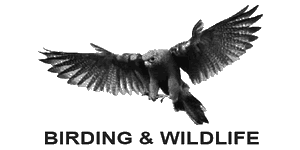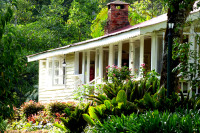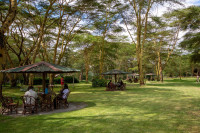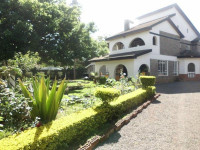
$2,929 pp (USD)
2 travelers on Start dateArrival
Arrival

Day 1
Pick up and add birding in Kisumu at the shores of lake Victoria, later drive to kakamega forest
Pick up and add birding in Kisumu at the shores of lake Victoria, later drive to kakamega forest
We shall be visiting this beautiful birding destination located on the shores on Lake Victoria, Africa’s largest fresh-water lake. Lake Victoria is also the second-largest fresh-water lake in the World. We shall bird here on foot as we seek the local birds. We shall also take a boat ride with our professional crew as we seek birds deeper into the lake and the inner swamps. Papyrus Gonolek, Black-headed Gonolek, Papyrus Canary, Woodland Kingfisher, Slender-billed Weaver, Northern Brown-throated Weaver, Long-toed Lapwing, Double-toothed Barbet, Black-billed Barbet, African Marsh-Harrier, Blue-headed Coucal, Red-chested Sunbird, Purple-banded Sunbird, Eastern Grey Plantain-eater, Rufous-chested Swallow, Beaudouin’s Snake-Eagle, Swamp Flycatcher, Greater Swamp Warbler, White-winged Swamp Warbler, Papyrus Yellow Warbler, Carruther’s Cisticola, Winding Cisticola, Red-faced Cisticola, Water Thick-knee, Yellow-fronted Tinkerbird. In the afternoon, you will transfer to Kakamega Forest.
- Main Destination:
- Kisumu (City)
- Accommodation:
- Rondo Retreat
- Meals & Drinks:

Day 2
Birding and Wildlife Kakamega Forest Whole Day
Birding and Wildlife Kakamega Forest Whole Day
Today with a site guide accompaniment, we go to the forest to look for African Emerald Cuckoo, Black-and-white-casqued Hornbill, Blue-headed Bee-eater, Yellow-billed Barbet, Gray-throated Barbet, Petit's Cuckooshrike, Western Black-headed Oriole, Chestnut Wattle-eye, African Shrike-flycatcher, Sharpe's Drong, African Blue Flycatcher, Turner's Eremomela, Olive-green Camaroptera, Banded Prinia, Black-faced Rufous-Warbler, Chubb's Cisticola, Black Sawwing, Angola Swallow, Joyful Greenbul, Uganda Woodland-Warbler and other more species. Hot lunch at the hotel.
- Main Destination:
- Kakamega Forest National Reserve
- Accommodation:
- Rondo Retreat
- Meals & Drinks:

Day 3
Birding on the Way to Lake Naivasha Area, Evening Birding at Crater Lake Sanctuary-Naivasha
Birding on the Way to Lake Naivasha Area, Evening Birding at Crater Lake Sanctuary-Naivasha
Crater Lake Conservancy Birding, is located in the heart of the Kenyan Rift Valley and is known for its stunning crater lake and diverse wildlife. The conservancy is a key area for eco-tourism and conservation in Kenya. Species
White-faced Whistling-Duck, Egyptian Goose, Yellow-billed Duck, Coqui Francolin, Ring-necked Dove, Laughing Dove, Dideric Cuckoo, Klaas's Cuckoo, Red-chested Cuckoo, Nyanza Swift, Little Swift, Horus Swift, African Palm Swift, Long-toed Lapwing, Blacksmith Lapwing, Spur-winged Lapwing, Crowned Lapwing, African Jacana, Marabou Stork, Yellow-billed Stork, African Darter, Long-tailed Cormorant, Great Cormorant, Hamerkop, Striated Heron, Western Cattle Egret, Great Egret, Yellow-billed Egret, Gray Heron, Black-headed Heron, African Sacred Ibis, Hadada Ibis, African Fish-Eagle, Speckled Mousebird, Green Woodhoopoe, African Gray Hornbill, Pied Kingfisher, White-fronted Bee-eater, Scaly-throated, Honeyguide, Greater Honeyguide, Mountain Gray Woodpecker.
- Main Destination:
- Lake Naivasha (Naivasha)
- Accommodation:
- Dove Nest Lodge
- Meals & Drinks:

Day 4
Birding at Kinangop Grasslands and Part of Aberdere Ranges
Birding at Kinangop Grasslands and Part of Aberdere Ranges
Wake up early and after breakfast, carry picnic lunch go to kinangop plateau to look out for Species like; Egyptian Goose, Yellow-billed Duck, Little Grebe, Red-eyed Dove
Ring-necked Dove
Little Swift
Red-knobbed Coot
Gray Crowned-Crane
Three-banded Plover
Blacksmith Lapwing
African Snipe
Long-tailed Cormorant
Hamerkop
Black-headed Heron
Hadada Ibis
Long-crested Eagle
Augur Buzzard
Speckled Mousebird
Cinnamon-chested Bee-eater
Chinspot Batis
Tropical Boubou
Fork-tailed Drongo
African Paradise-Flycatcher
Northern Fiscal
Cape Crow
Pied Crow
Tawny-flanked Prinia
Gray-capped Warbler
Hunter's Cisticola
Rattling Cisticola
Levaillant's Cisticola
Wing-snapping Cisticola
Black Sawwing
Red-rumped Swallow
Common Bulbul
Superb Starling
White-eyed Slaty-Flycatcher
Cape Robin-Chat
White-browed Robin-Chat
African Stonechat
Northern Anteater-Chat
Amethyst Sunbird
Bronze Sunbird
Golden-winged Sunbird
Variable Sunbird
Baglafecht Weaver
Speke's Weaver
Yellow Bishop
Long-tailed Widowbird
Jackson's Widow.
- Main Destination:
- Aberdare National Park
- Accommodation:
- Lake Naivasha Crescent Camp
- Meals & Drinks:

Day 5
Drive to Nairobi National Park and Bird Here for the rest of the Day
Drive to Nairobi National Park and Bird Here for the rest of the Day
With our picnic lunch, we shall checkout early and drive for 2hours to Nairobi National Park and start game drive for wildlife and birds like;
Species
Common Ostrich
Egyptian Goose
Helmeted Guineafowl
Crested Francolin
Common Quail
Yellow-necked Spurfowl
Little Grebe
Red-eyed Dove
Emerald-spotted Wood-Dove
Hartlaub's Turaco
White-browed Coucal
Little Swift
African Palm Swift
African Rail
Gray Crowned-Crane
Spotted Thick-knee
Three-banded Plover
Blacksmith Lapwing
Crowned Lapwing
Marabou Stork
Yellow-billed Stork
Long-tailed Cormorant
Hamerkop
Western Cattle Egret
Great Egret
Yellow-billed Egret
Gray Heron
African Sacred Ibis
Hadada Ibis
African Spoonbill
White-backed Vulture
Black Kite (Yellow-billed)
Speckled Mousebird
Pied Kingfisher
Little Bee-eater
Yellow-rumped Tinkerbird
Spot-flanked Barbet
White-headed Barbet
Chinspot Batis
Tropical Boubou
Slate-colored Boubou
Long-tailed Fiscal
Pied Crow
Rufous-naped Lark
Moustached Grass-Warbler
Green-backed Camaroptera and many more.
- Main Destination:
- Nairobi National Park
- Accommodation:
- Hotel Troy
- Meals & Drinks:

Day 6
Drive to Taveta Town
Drive to Taveta Town
Tsavo National Park is one of Kenya's largest and oldest national parks, split into Tsavo East and Tsavo West. It covers a vast area of approximately 21,000 square kilometers (8,000 square miles) in southeastern Kenya, making it one of the largest protected areas in the country. Birding at Tsavo National Park is a rewarding experience due to the park's diverse habitats and range of bird species. Tsavo East offer excellent birdwatching opportunities, with varied ecosystems providing homes to a wide range of avian species.
- Main Destination:
- Taita Hills Wildlife Sanctuary
- Accommodation:
- Kivuko Eco Camp
- Meals & Drinks:

Day 7
Birding at Taita Hills Wildlife Sanctuary-Ngangao Forest
Birding at Taita Hills Wildlife Sanctuary-Ngangao Forest
Birdwatching at Taita Wildlife Sanctuary is a rewarding experience due to its diverse habitats and the presence of several rare and endemic bird species. The sanctuary’s varied environments, from forested areas to open grasslands, create excellent opportunities for spotting a wide range of bird species. Birding at Ngangao Forest for its rich birdlife, including many endemic and forest-dependent species. It’s a key location for finding the Taita apalis and Taita white-eye.
- Main Destination:
- Taita Hills Wildlife Sanctuary
- Accommodation:
- Kivuko Eco Camp
- Meals & Drinks:

Day 8
Birding to Malindi Town
Birding to Malindi Town
Birding along the route from Taita Hills to Malindi offers a fantastic opportunity to experience a variety of Kenya's ecosystems, ranging from montane forests to coastal savannas and wetlands. This diverse transition in habitat creates a rich array of bird species. On the way, you may be chanced to see Taita Thrush– one of the key species here, an endemic found only in the Taita Hills, Taita Apalis – another endemic, often found in the dense forest understory. Other Notable Species like; White-headed Wood Hoopoe, Jackson's Hornbill, Hartlaub's Turaco.
- Main Destination:
- Malindi (Beach)
- Accommodation:
- Sandies Malindi Dream Garden
- Meals & Drinks:
Day 9
Birding Dakacha
Birding Dakacha
Today very early after breakfast, we check out and drive to Dakacha Woodlands for birding looking out for;
Clark's/Kilifi weaver
Barred Owlet
Thick-billed Cuckoo
Black-collard Barbet
Retz Helmet Shrike
Madagascar Bee-eater and other many more. Birding at Dakacha (often referred to as Dakacha Conservancy or Dakacha Wilderness) offers a unique and fascinating birding experience, as this remote region lies in the northern part of Coastal Kenya, in the Tana River Basin. It is a largely unexplored and pristine area of dryland savanna and acacia woodland, offering birders the chance to encounter both common species and more elusive, arid-zone specialties. The Dakacha area is known for its mixture of dryland forests, savanna, and bushland, with large tracts of lowland acacia and communal grazing lands that support a range of bird species. The region is relatively sparsely populated and free from major development, which has allowed wildlife and birdlife to thrive undisturbed.
- Main Destination:
- Dakatcha Woodland (Highlight)
- Accommodation:
- Sandies Malindi Dream Garden
- Meals & Drinks:

Day 10
Birding Arabuko Sokoke and drive to Malindi International Airport for Return Flight
Birding Arabuko Sokoke and drive to Malindi International Airport for Return Flight
Today Early Morning you drive to Arabuko Sokoke Forest and bird here wholde day. Arabuko Sokoke is one of Kenya's premier birding destinations, and it’s considered one of the most important coastal forest ecosystems in East Africa. Located near the town of Watamu, in Kilifi County, Arabuko Sokoke is a UNESCO Biosphere Reserve and a crucial birding hotspot. Its biodiversity is remarkable, with several species found nowhere else in the world. The forest offers a variety of habitats, from coastal dry forests to wetlands, providing ideal conditions for both resident and migratory bird species. Arabuko Sokoke covers about 400 square kilometers of coastal forest and is a unique blend of mature forest, coastal woodland, scrubland, and wetlands, with high biodiversity. The forest is home to a range of endemic and globally threatened species, making it a key site for bird conservation and birdwatching.
- Main Destination:
- Arabuko Sokoke Forest Reserve
- Accommodation:
- No accommodation (End of tour)
- Meals & Drinks:







































